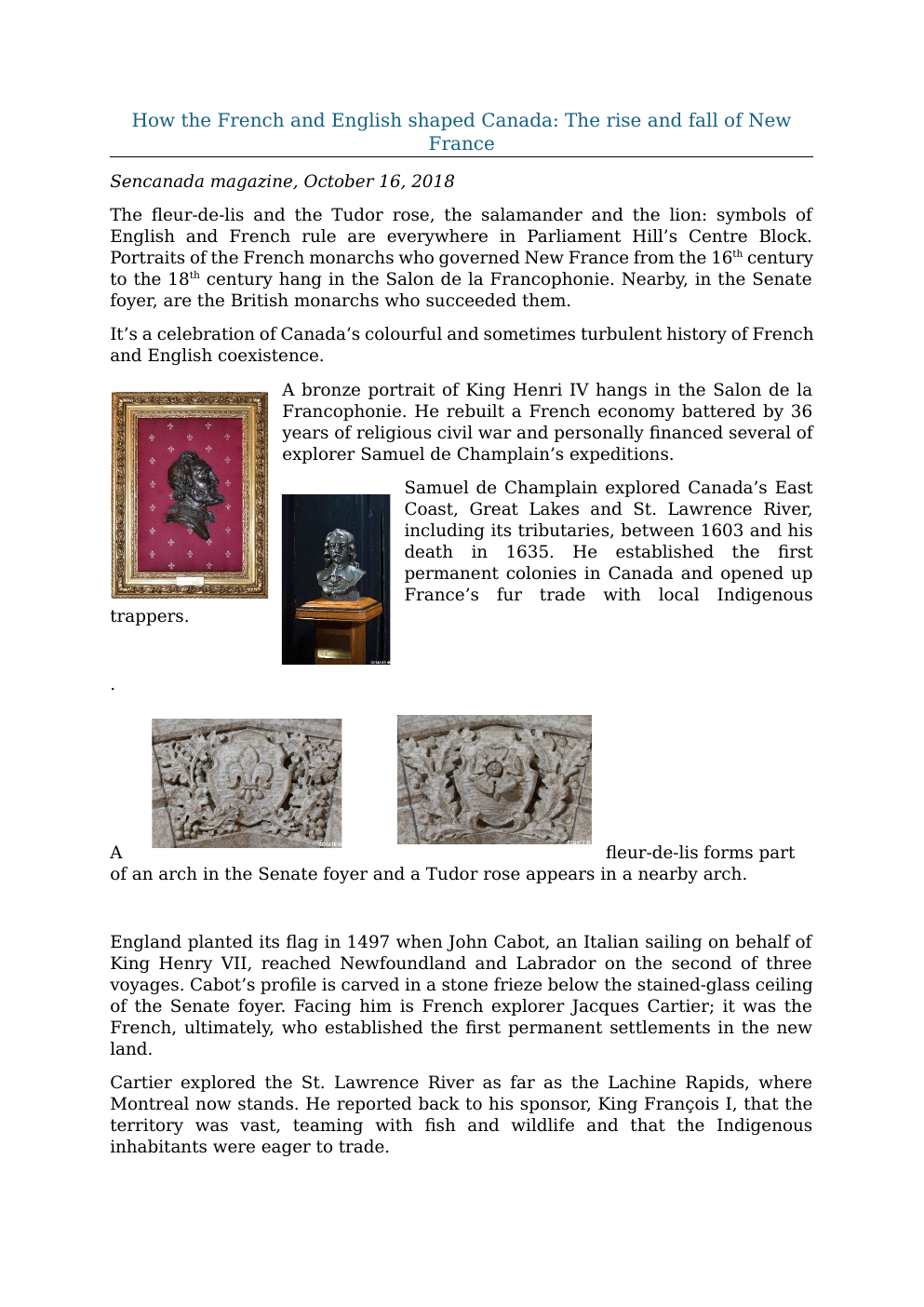How the French and English shaped Canada: The rise and fall of New France
Publié le 18/05/2025
Extrait du document
«
How the French and English shaped Canada: The rise and fall of New
France
Sencanada magazine, October 16, 2018
The fleur-de-lis and the Tudor rose, the salamander and the lion: symbols of
English and French rule are everywhere in Parliament Hill’s Centre Block.
Portraits of the French monarchs who governed New France from the 16th century
to the 18th century hang in the Salon de la Francophonie.
Nearby, in the Senate
foyer, are the British monarchs who succeeded them.
It’s a celebration of Canada’s colourful and sometimes turbulent history of French
and English coexistence.
A bronze portrait of King Henri IV hangs in the Salon de la
Francophonie.
He rebuilt a French economy battered by 36
years of religious civil war and personally financed several of
explorer Samuel de Champlain’s expeditions.
Samuel de Champlain explored Canada’s East
Coast, Great Lakes and St.
Lawrence River,
including its tributaries, between 1603 and his
death in 1635.
He established the first
permanent colonies in Canada and opened up
France’s fur trade with local Indigenous
trappers.
.
A
fleur-de-lis forms part
of an arch in the Senate foyer and a Tudor rose appears in a nearby arch.
England planted its flag in 1497 when John Cabot, an Italian sailing on behalf of
King Henry VII, reached Newfoundland and Labrador on the second of three
voyages.
Cabot’s profile is carved in a stone frieze below the stained-glass ceiling
of the Senate foyer.
Facing him is French explorer Jacques Cartier; it was the
French, ultimately, who established the first permanent settlements in the new
land.
Cartier explored the St.
Lawrence River as far as the Lachine Rapids, where
Montreal now stands.
He reported back to his sponsor, King François I, that the
territory was vast, teaming with fish and wildlife and that the Indigenous
inhabitants were eager to trade.
It was King Henri IV, whose portrait hangs near François I’s in the Salon de la
Francophonie, who seized this commercial opportunity.
He enlisted Samuel de
Champlain, a man often referred to as the “Father of New France”, to open up
trade in the New World.
Champlain, whose bronze bust stands nearby, led dozens
of expeditions in the 1600s, establishing permanent settlements at Port Royal on
the Bay of Fundy and at Quebec City.
King Louis XIV made populating the territory a priority and, by the 1700s, it
seemed like New France was about to bloom.
However, an awkward alliance with
Austria, Russia and Spain dragged France into the Seven Years War in 1756.
Known in North America as the French and Indian War, it was a sprawling conflict
that ended up benefiting Great Britain at everyone else’s expense.
Two centuries of French rule began to unravel in the 1750s.
King Louis XV is the
last of nine Ancien Régime kings whose portraits hang in the Salon de la
Francophonie.
These French monarchs governed New France from the 1500s to
the 1700s.
King George III, whose portrait hangs around the corner in the Senate foyer, is
the first of nine British monarchs who succeeded them.
French and English heraldic symbols,
including the fleur-de-lis, the Tudor
rose and the Tudor Crown, embellish
a clock in front of the Senate
Chamber’s public gallery.
A Tudor rose,
a traditional emblem of England, is
carved in the back of the Senate
Speaker’s chair
France, heavily committed to fighting in Europe, stretched what few resources it
had to defend its scattered colonial outposts.
Britain’s increasingly powerful navy
harassed it on all fronts.
The Fortress of Louisbourg....
»
↓↓↓ APERÇU DU DOCUMENT ↓↓↓
Liens utiles
- What are the influences of the Gilead society and how they have an impact on the woman’s lives?
- Isaac Newton I INTRODUCTION Isaac Newton (1642-1727), English physicist, mathematician, and natural philosopher, considered one of the most important scientists of all time.
- Essay English : In Arthur Miller's play "All my sons", Joe Keller is a hero in his family and in the neighborhood even if he did some very awful things.
- Placed under the dual sovereignty of the bishop of Urgel and thePresident of the French Republic, Andorra is the highest inhabitedcountry in Europe.
- The Rights of Man DeclarationWith this declaration, the French National Assembly addressed many of the French people's grievances with the monarchy and established the ideals of the FrenchRevolution.


